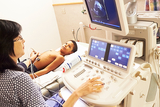What is truncus arteriosus?
When the fetus develops during pregnancy, the heart starts with a single large blood vessel coming from the heart called the truncus arteriosus. As fetal development progresses and the heart develops normally , the truncus divides into two arteries that carry blood out of the heart:
- The pulmonary artery, which is attached to the bottom right chamber (ventricle) of the heart. It divides into two arteries carrying oxygen-poor ("blue") blood to the lungs.
- The aorta, which is attached to the bottom left chamber (ventricle) of the heart. It carries oxygen-rich ("red") blood to the body.
Sometimes the single large blood vessel fails to divide during fetal development and the baby is born with a heart that has one artery carrying blood out of it. This congenital heart disease is known as truncus arteriosus or persistent truncus arteriosus (the trunk "persists").
The undivided trunk is attached to the heart as one artery straddling the bottom chambers and then divides into arteries taking blood to the lungs and body. The oxygen-poor blood from the right ventricle (bottom chamber) and the oxygen-rich blood from the left ventricle (bottom chamber) mix when ejected out into the trunk, and more blood than normal goes back to the lungs. This makes it harder for the infant to breathe.
In almost all cases, children with the congenital heart defect truncus arteriosus also have a large hole between the bottom chambers of the heart. This is called a ventricular septal defect (VSD).
In rare cases, there may be an interrupted aortic arch seen with truncus arteriosus and the child may need medication to allow blood flow to get to the body.
As a result of these abnormalities, the baby's blood isn't as oxygenated as it should be when it circulates through the body.
Signs and symptoms of truncus arteriosus
Signs and symptoms of truncus arteriosus usually appear within the first days of life and may include:
- Blue or purple tint to lips, skin and nails (cyanosis)
- Poor eating and poor weight gain
- Rapid breathing or shortness of breath
- Profuse sweating, especially with feeding
- More sleepiness than normal
- Unresponsiveness
- Heart murmur — the heart sounds abnormal when a doctor listens with a stethoscope
Testing and diagnosis of truncus arteriosus
Usually truncus arteriosus is diagnosed before the baby leaves the hospital if the doctor hears a murmur or sees a blue tint to the lips or skin. Or, a primary care pediatrician might detect the symptoms of truncus arteriosus during a checkup or a parent might notice symptoms and bring the baby to a doctor or hospital.
Diagnosis of truncus arteriosus may require some or all of these tests:
- Pulse oximetry: a noninvasive way to monitor the oxygen content of the blood
- Electrocardiogram (ECG): a record of the electrical activity of the heart
- Echocardiogram (also called "echo" or ultrasound): sound waves create an image of the heart
- Chest X-ray
- Cardiac MRI : a three-dimensional image shows the heart's structures in detail
- Cardiac catheterization : a thin tube is inserted into the heart through a vein and/or artery in the leg which makes measurements throughout the heart
Often, truncus arteriosus is diagnosed on a fetal ultrasound and/or echocardiogram. The Fetal Heart Program at CHOP specializes in the detection, evaluation and management of congenital heart defects like truncus arteriosus prior to a baby's birth, and can prepare a plan for delivery and care immediately after birth.
A number of children with truncus arteriosus also have a genetic syndrome called 22q11 deletion syndrome (also known as DiGeorge, velocardialfacial or conotruncal anomaly face syndromes). Genetic testing (a blood test) for this syndrome may be part of our evaluation.
Treatment for truncus arteriosus
Open heart surgery is required to treat truncus arteriosus, usually before the baby is 2 months old. More than one operation may be required.
Cardiothoracic surgeons place a patch to close the hole (the ventricular septal defect). They separate the pulmonary arteries from the trunk, and then connect the pulmonary arteries to the right bottom chamber (ventricle) of the heart using different kinds of conduits (tubes). They repair the trunk so that it becomes a complete, functioning aorta. Other repairs may be needed, based on each child's unique needs.
Following surgery, your child will initially recover in the Evelyn and Daniel M. Tabas Cardiac Intensive Care Unit (CICU), where he will receive round-the-clock attention from a team of dedicated cardiac critical care medicine specialists. As his condition improves, he will be moved to the Cardiac Care Unit.
Outlook for truncus arteriosus
Truncus arteriosus is a life-threatening congenital heart defect; most babies won't live for more than a few months without treatment.
Because of enormous strides in medicine and technology, today most children with heart defects such as truncus arteriosus who do receive treatment will go on to lead productive lives as adults.
Follow-up care for truncus arteriosus
Early years (0-5 years)
As a group, children with complex congenital heart defects who have had open heart surgery as infants are at a higher risk for neurodevelopmental issues when compared to children without congenital heart defects. The Cardiac Center at CHOP created the Cardiac Kids Developmental Follow-up Program to provide evaluation, screening and clinical care for children with complex congenital heart disease who are at risk for neurodevelopmental problems.
Through age 18
A child who has had surgical repair of truncus arteriosus will require lifelong care by a cardiologist.
Our pediatric cardiologists follow patients with truncus arteriosus until they are young adults, coordinating care with the primary care physician. Patients will need to carefully follow doctors' advice, including staying on any medications prescribed and, in some cases, limiting certain types of exercise.
Sometimes children with truncus arteriosus experience heart problems later in life, including irregular heartbeat (arrhythmia), a restricted conduit or pulmonary artery, or a leaky aortic valve. Medicine, surgery and/or cardiac catheterization may be required.
Into adulthood
We will help patients who have had truncus arteriosus treatment transition care to an adult cardiologist.
The Philadelphia Adult Congenital Heart Center, a joint program of Children's Hospital of Philadelphia and Penn Medicine, meets the unique needs of adults who were born with heart defects such as truncus arteriosus.

Patient Outcomes at the Cardiac Center
Children’s Hospital of Philadelphia's pediatric heart surgery survival rates are among the best in the nation.
Resources to help
Cardiac Center Resources
We know that caring for a child with a heart condition can be stressful. To help you find answers to your questions – either before or after visiting the Cardiac Center – we’ve created this list of educational health resources.
Reviewed by Jenna Heichel, MSN, BSN, CRNP
Reviewed on 08/08/2024
